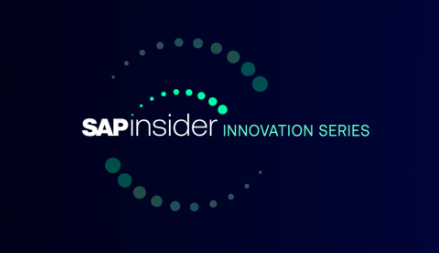SAP Supply Chain Management
SAP APO | SAP Asset Management | SAP Business Network | SAP Digital Manufacturing Cloud | SAP Digital Twin | SAP EWM | SAP IBP | SAP Inventory Management | SAP Label Printing | SAP Logistics | SAP Manufacturing | SAP Manufacturing Automation | SAP MES | SAP MII | SAP MM | SAP MRO | SAP MRP | SAP Order Management | SAP Plant Maintenance | SAP PLM | SAP Production Planning | SAP S&OP | SAP SD | SAP SPM | SAP Supply Chain Planning | SAP Track and Trace | SAP Transportation Management
Filter By
Browse By
- SAP Analytics and AI
- SAP Application Development and Integration
- All SAP Application Development and Integration
- SAP ABAP
- SAP ABAP Development Tools
- SAP ABAP Test Cockpit
- SAP API Management
- SAP BAPI
- SAP Basis
- SAP BRF
- SAP Business Application Studio
- SAP CMS
- SAP Design Studio
- SAP Development Tools
- SAP DevOps
- SAP EAI
- SAP EDI
- SAP Extension Suite
- SAP Fiori
- SAP Fiori Elements
- SAP Integration Suite
- SAP Low Code Application Development
- SAP Low Code Automation
- SAP Netweaver
- SAP Release Management
- SAP UI5
- SAP Web Application Server
- SAP Web IDE
- SAP Business Process Management
- SAP Center of Excellence
- SAP CIO
- SAP Customer Experience
- SAP Data and Data Management
- All SAP Data and Data Management
- SAP BW
- SAP BW/4HANA
- SAP Crystal Reports
- SAP Data Archiving
- SAP Data Center
- SAP Data Governance
- SAP Data Integration
- SAP Data Migration
- SAP Data Quality
- SAP Data Services
- SAP Data Strategy
- SAP Data Visualization
- SAP Data Warehouse Cloud
- SAP DMS
- SAP Document Control
- SAP EIM
- SAP ETL
- SAP ETL Tools
- SAP HANA
- SAP HANA Administration
- SAP HANA Deployment Infrastructure
- SAP HANA Studio
- SAP Master Data
- SAP Master Data Governance
- SAP MDM
- SAP Enterprise Architect
- SAP Enterprise Asset Management
- SAP ERP
- SAP Finance
- All SAP Finance
- SAP Accounting
- SAP AR AP
- SAP Asset Accounting
- SAP Billing Systems
- SAP BPC
- SAP BRIM
- SAP Cash Management
- SAP Central Finance
- SAP Controlling
- SAP COPA
- SAP Cost Center Accounting
- SAP Currency Risk
- SAP e-invoicing
- SAP FICO
- SAP Finance Automation
- SAP Advanced Financial Closing
- SAP Financial Consolidation
- SAP Financial Planning
- SAP FX Risk
- SAP General Ledger
- SAP Global Tax Management
- SAP Hyperion
- SAP Order to Cash
- SAP Payment Processing
- SAP Profitability Analysis
- SAP Rebate Management
- SAP S/4HANA Finance
- SAP SWIFT Compliance
- SAP Treasury Management
- SAP Universal Journal
- SAP Governance Risk and Compliance
- SAP Human Capital Management
- SAP Intelligent Technologies
- SAP Platform and Technology
- All SAP Platform and Technology
- SAP Business Technology Platform
- SAP Cloud
- SAP Cloud Connector
- SAP Cloud Integration Platform
- SAP Cloud Migration
- SAP Cloud Platform
- SAP Cloud Providers
- SAP Cloud Strategy
- SAP Digital Signature
- SAP Container Platform
- SAP HANA Enterprise Cloud
- SAP Digital Asset Management
- SAP Smart Forms
- SAP HEC
- SAP Digital Integration Hub
- SAP Hyperscalers
- SAP Infrastructure
- SAP Messaging
- SAP Quality and Testing
- SAP Security
- SAP Spend Management
- SAP Supply Chain Management
- All SAP Supply Chain Management
- SAP APO
- SAP Asset Management
- SAP Business Network
- SAP Digital Manufacturing Cloud
- SAP Digital Twin
- SAP EWM
- SAP IBP
- SAP Inventory Management
- SAP Label Printing
- SAP Logistics
- SAP Manufacturing
- SAP Manufacturing Automation
- SAP MES
- SAP MII
- SAP MM
- SAP MRO
- SAP MRP
- SAP Order Management
- SAP Plant Maintenance
- SAP PLM
- SAP Production Planning
- SAP S&OP
- SAP SD
- SAP SPM
- SAP Supply Chain Planning
- SAP Track and Trace
- SAP Transportation Management
- SAP System Administration
SAP Supply Chain: Supply Chain Management
A well-managed supply chain can significantly reduce a company’s operating expenses and increase profits. A supply chain requires active management because it is affected by many factors outside the control of the business. Current events causing global supply chain disruptions include the Russia-Ukraine War and the continuing effects of COVID-19.
SAP Supply Chain: Supply Chain Management
A well-managed supply chain can significantly reduce a company’s operating expenses and increase profits. A supply chain requires active management because it is affected by many factors outside the control of the business. Current events causing global supply chain disruptions include the Russia-Ukraine War and the continuing effects of COVID-19.
Supply chain management is the flow of goods or services between businesses and various locations to get goods to consumers faster and at less cost. Supply chain management encompasses a thread of activities from design and manufacturing to delivery and operations.
Components to enable a resilient and sustainable supply chain management process are:
- Designing recyclable and sustainable products
- Delivering products with low carbon impact
- Planning to reduce emissions and ethically source materials
- Operating in an energy efficient and safe manner
- Manufacturing with minimal waste and environmental impact.
Accurate information helps manufacturers and retailers produce and transport only what they can sell, eliminating unnecessary expenses. Consider simplification by integrating demand planning in the cloud. Predictive analytics, automation, and Internet of Things (IoT) technologies can connect and simplify processes, allowing you to gain visibility across forecasting, response and supply, replenishment, and inventory.
Key Capabilities of Supply Chain Management:
- Supply Chain Planning: Agile market-driven plans with visibility, collaboration, and intelligence.
- Supply Chain Logistics: Fast, efficient, and sustainable logistics.
- Manufacturing: Streamlining with artificial intelligence, loT, and integration.
- Product Lifecycle Management: Connecting systems, people, and processes with end-to-end digital innovation.
- Enterprise Asset Management: Improving asset performance and reliability.
Benefits of Supply Chain Management:
- Optimizing the flow of materials, products, and information.
- Improving data visibility.
- Enhancing financial practices and cost cutting.
- Improving vendor relationships.
- Operating with lean and on-demand inventory.
- Reducing liability and risk.
Key Considerations for SAPinsiders
- How to Deliver Greater Visibility into the Operational KPIs that Drive Your Business. In this webinar, hear insights from SAP around how to build a powerful analytics foundation. Discover how to focus less on historical KPI’s and more on predictive process automation, how to reprioritize KPIs that show historical performance, develop operational decision support for end-to-end supply chain processes, and stop development of custom reporting.
- 5 Ways to Enhance Your SCM with Smart Data. Explore expert insights from Robert Brice, President and CTO, RFgen. Start with the basics for a digital transformation of your supply chain, discover how to gain competitive advantage by implementing efficiencies, address inefficiencies, shortage of labor, and address security.
- Salling Group Expands Its Market Reach With SAP. In this article, see how Salling Group used SAP ERP to ensure data uniformity, enhance warehouse efficiency, and consolidated logistics transactions with Redwood.
558 results
-

Leverage SAP Ariba for Effective Supplier Management
Reading time: 3 mins
The role of procurement has changed dramatically in recent years, and supply chain leaders must now strategically leverage this function, and more specifically the procure-to-pay (P2P) function within the procurement process, to effectively manage supplier relationships. In the past, procurement was primarily focused on invoices and payments. Today it is about digitizing workflows and integrating...…
-

 Premium
Premium
Automate Global Import/Export Processes Across Your Enterprise with SAP GTS
Reading time: 12 mins
For many companies, import/export trade processes are conducted manually. Automating these processes will reduce errors and reduce costly maintenance. SAP has introduced Global Trade Services (GTS), an application that runs on the NetWeaver platform, to help automate processes whether they run within or outside the R/3 enterprise structure. Get an inside look at GTS’s capabilities...…
-

 Premium
Premium
SAPinsider Research: Integrating Supply Chain Planning & Operations
Now more than ever, in a year marked by the need to adjust to massive changes in business, restricted shipping capabilities, and limited providers, supply chain managers need modern planning tools to adapt to the volatility of the market as well as the ability to share and execute their plans. These tools include demand, supply,…
-
-

Instill Operational Agility Into Your Organizational Fabric
Reading time: 9 mins
Companies face an onslaught of marketplace volatility, requiring an approach that balances people and technology. The market landscape is in a state of rebuilding. Raw material shortages, supplier insolvencies, and a host of other issues pose challenges to companies and their supply chains. Those enterprises that have adapted have one thing in common — operational…
-

Increase Service Levels and Lower Inventory with SAP DDMRP
Reading time: 4 mins
Demand-driven material requirements planning (DDMRP) is a solution to plan materials and inventories. While traditional MRP does a respectable job of planning, DDMRP improves on that functionality to work better in a volatile environment. It enables companies to get closer to customers’ requirements, promoting faster decisions at the planning and execution level. Why can’t sales,…
-

- SAP Data and Data Management
 Premium
Premium
Digital Automation Starts with Inventory
Reading time: 5 mins
A digitally enhanced and optimized mobile supply chain drives efficiency, agility, and future growth. It helps shift focus from resource drain to process automation, leading to better data and real-time SAP integration. The result is a transformed supply chain and inventory-focused operation built for success. Membership Required You must be a member to access this…
-

- SAP Data and Data Management
 Premium
Premium
How PPG Industries Uses SAP ERP Data to Optimize Its Supply Chain Performance
Click Here to View Session Deck. SAP is a great ERP system to maintain your critical business data and implement standardized, efficient business processes. However, companies struggle to get the information out of their SAP systems that reveals end-to-end supply chain processes and can inform daily decision making. Considerable time and costs are devoted to...…
-
-

 Premium
Premium
Pick n Pay Benefits from a New Retailing Solution
Reading time: 10 mins
SAP S/4HANA offers enterprises tremendous potential to go beyond performance and simplicity and deliver significant business value as part of an enterprise-wide digital transformation, but this approach must be understood, considered and incorporated into by SAP and Partners SAPinsider - 2006 (Volume 7), January (Issue 1) by SAP and Partners SAPinsider - 2006 (Volume 7),…
-

 Premium
Premium
The Recipe for Standardized Training at General Mills
Reading time: 9 mins
SAP S/4HANA offers enterprises tremendous potential to go beyond performance and simplicity and deliver significant business value as part of an enterprise-wide digital transformation, but this approach must be understood, considered and incorporated into by SAP and Partners SAPinsider - 2006 (Volume 7), January (Issue 1) by SAP and Partners SAPinsider - 2006 (Volume 7),…
-

- SAP Supply Chain Management
 Premium
Premium
Cross-Plant Planning in SAP ERP or S/4HANA with the Add-On Cross-Plant Planning (CPP) – Part 2
Reading time: 9 mins
There are two primary methods for conducting cross-plant planning within S/4HANA. One involves utilizing the special procurement key in MRP, while the other entails employing the SAP Add-on Cross-plant planning. This series aims to familiarize users with the cross-plant planning options available in SAP S/4HANA. Part 1 covers the options with MRP Live or the…
Become a Member
Unlimited access to thousands of resources for SAP-specific expertise that can only be found here.
Become a Partner
Access exclusive SAP insights, expert marketing strategies, and high-value services including research reports, webinars, and buyers' guides, all designed to boost your campaign ROI by up to 50% within the SAP ecosystem.
Upcoming Events
Related Vendors
Your request has been successfully sent


